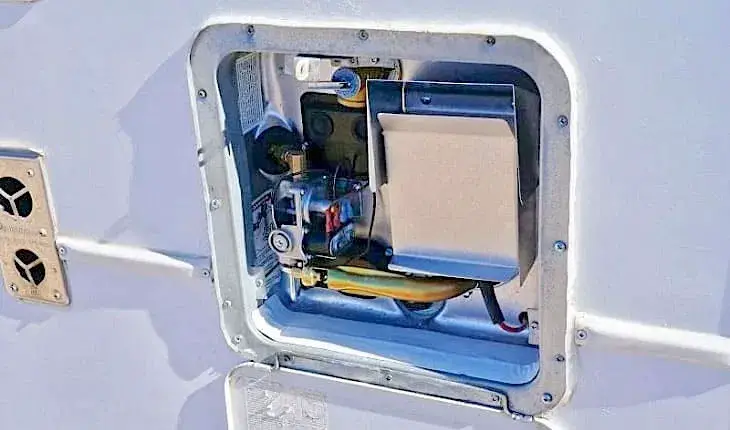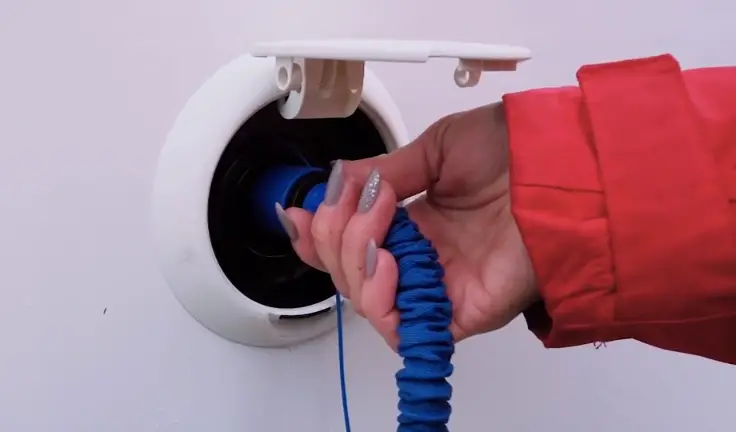Nobody wants to find out the water heater is empty while taking a shower. So, you may want to make sure it’s full before you take your RV out on the road. But how do you know if your RV Water Heater is full?
To know if your RV water heater is full, make sure the hot water tank is connected to your RV’s plumbing. Your heater valves shouldn’t be in bypass mode and the hot water tap must be open. When you see water running from your tap, your hot water tank is full, and you can turn on the heater.

If you want to fill your water heater, you’re in luck. These instructions will provide you with everything you need to know about filling a water heater, and even teach you some things about your RV’s plumbing systems. Furthermore, if you’re looking to learn more about van life in general, I made a special resource page about the subject here.
How Do I Know if My RV Water Heater Has Water in It?
To find out if your water heater tank has water, leave a faucet or the tank’s Pressure and Temperature Relief (PTR) valve open when filling your water tank. You’ll hear sputtering at first as the incoming water displaces air. When water starts flowing consistently from the tap or PTR valve, close them. Your hot water tank is now full.

If you’re hooked up to city water, you can disconnect the hose after your water tank is full, then open the sink’s hot water valve until water comes out of the faucet. When done, reconnect city water and turn off the water pump. Doing this tops off both the water heater and the freshwater tank, giving you extra water for long trips and dry climates.
Find this content useful 🙂 ?
Subscribe to our Newsletter and get a free Solar Electric Diagram + shopping list.
Why Isn’t My RV Water Heater Filling Up?
If your RV’s water heater isn’t filling up, your hot water tank valves may be in bypass mode. RV water lines are very thin and require an RV antifreeze like Prestone RV/Marine Waterline Antifreeze (available at Amazon.com) to avoid cracking during the winter. But you don’t want antifreeze in your heater.
Your RV’s water heater has a bypass valve that shunts incoming water away from the heater when switched to avoid that issue. This bypass lets you store your RV safely away for the winter, knowing that antifreeze is protecting the fragile lines and staying out of your shower water.
Close your bypass valve to reconnect your water heater to your RV’s plumbing system. If you don’t know how to locate your bypass valve, consult your owner’s manual. Owner’s manuals are available online for all major RV manufacturers and will assist you in the process.
Do I Need To Drain My RV Water Heater?
You should drain your RV water heater after each trip. Standing water stagnates, and warm water is an especially fertile breeding ground for bacteria. Water left in your RV’s water heater will acquire an unpleasant sulfur smell.

A flushing wand like the Camco Water Heater Tank Rinser (available at Amazon.com) will help you flush out anaerobic bacteria that leave your hot water stinking of rotten eggs. Flushing your tank won’t only make washing your hands more pleasant, but it’ll also extend the life of your RV water heater.
Pouring hydrogen peroxide or household vinegar into your tank will also help get rid of both germs and stench. Drain any smelly water from your tank beforehand, but ensure you stand clear of the backwash!
How Long Does an RV Water Heater Take To Heat Up?
An RV water heater tank can take anywhere from 20 to over 60 minutes to heat up, depending on size and heating method. RV water heaters come in 6-gallon (22.7 L) or 10-gallon (38 L) sizes. Larger tanks hold more hot water but also take longer to heat.

Most RV water heaters run on electricity, gas, or a combination of both. According to RV supplier Recpro:
- Gas models heat 7.4 – 13.5 gallons (28-51.10 L) per hour.
- Electric models heat 5.8 – 6.2 gallons (22-23.5 L) per hour.
- Combination gas/electric models can heat over 16 gallons (60.57 L) an hour.
Some modern RVs also use your engine’s waste heat to warm your water as you drive. And a few high-end RVs use diesel-powered electric central heating. Consult your owner’s manual or dealer if you have any questions about your RV’s water heater.
Should You Leave Your RV Water Heater On?
So long as there’s water in the tank, it’s safe to leave your RV water heater on. Because it can take a while for RV water heaters to warm up, many campers keep them running all the time.
If you’re parked at a campground and plugged into their power grid, there’s no issue leaving your water heater on. But when traveling, the water heater uses up battery amps. So if you’re using many other electrical systems, you may benefit from turning off your RV water heater until you need to use it.
What Happens If You Turn On an Empty Water Heater?
You should always ensure your hot water tank is full before you turn on the heater. If you turn on the heater and the tank is empty, you’ll burn out your electrical heating element almost immediately. Never turn on your water heater unless you see water coming out of the tap.
If you just discovered this the hard way, never fear. As RV repairs go, replacing a heating element is easy and inexpensive. To replace a burned-out heating element:
- Drain the water tank.
- Disconnect all power supplies to avoid shocks and ensure your element doesn’t start getting hot while you’re working.
- Remove the water heater’s drain plug cap and anode rod. The anode rod prevents tank corrosion. If it looks deteriorated or smells unpleasant, replace it.
- Remove the heating element cover. You may have to move a tube or otherwise clear a space to do this. Consult your owner’s manual.
- Unscrew and remove the old water heating element. You may need a specialized wrench like this RV Water Heater Element Wrench at Amazon.com.
- Connect and install a new heating element. Most RV water tank heating elements cost $25 or less, so this fix won’t break your budget.
If you’re still having issues with your RV water heater, this Youtube video offers some troubleshooting tips:
Related Article: How To Test Your RV Thermocouple (in 4 Steps)
Conclusion
Now you know more about your RV’s water heater and how it works. Armed with this knowledge, you should have no trouble ensuring your trips are blessed with an abundant supply of hot water. Happy travels!

